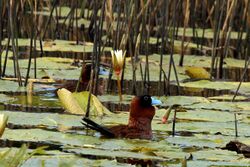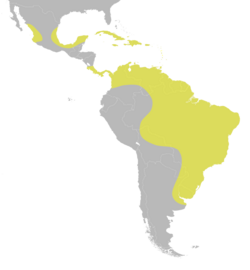Biology:Masked duck
| Masked duck | |
|---|---|

| |
| Adult males, Tobago | |
| Scientific classification | |
| Domain: | Eukaryota |
| Kingdom: | Animalia |
| Phylum: | Chordata |
| Class: | Aves |
| Order: | Anseriformes |
| Family: | Anatidae |
| Genus: | Nomonyx Ridgway, 1880 |
| Species: | N. dominicus
|
| Binomial name | |
| Nomonyx dominicus (Linnaeus, 1766)
| |

| |
| Synonyms | |
| |
The masked duck (Nomonyx dominicus) is a tiny stiff-tailed duck ranging through the tropical Americas.
Taxonomy
The only member of the genus Nomonyx, it is intermediate between the rather primitive black-headed duck (Heteronetta) and the very apomorphic true stiff-tailed ducks. It is sometimes included with the latter in the genus Oxyura, but the masked ducks are now considered the descendants of a missing link in the Oxyurini evolution, having changed little for millions of years.[2][3]
Distribution and habitat
They are found from southern Texas and Mexico to South America and also in the Caribbean. Primarily not migratory, masked ducks are reported as very uncommon vagrants in the southernmost United States , along the Mexican border and in Florida. As of 2000, the conservation status for masked ducks in Texas is 3,800 birds.[4] On April 1, 1962, it was recorded from Lowndes County, Georgia, where it was photographed by Alexander Wetmore.[5] Masked ducks breed in any freshwater body with marsh vegetation and surrounded by heavy tree cover. They also occur in mangrove swamps.
Description
Breeding adult males have a rust-colored body with a black face and mottled wings. Adult females, winter males, and juveniles have a barred brownish gray body, with two horizontal, dark-colored stripes running through the buff-colored face.
Diet
These ducks mainly feed on seeds, roots, stems,[6] and leaves of aquatic plants. They also eat aquatic insects and crustaceans. They feed by diving. These ducks are usually very secretive, but they are not rare and not considered threatened by the IUCN.[1]
References
- ↑ 1.0 1.1 BirdLife International (2021). "Nomonyx dominicus". IUCN Red List of Threatened Species 2021: e.T22679789A137758280. https://www.iucnredlist.org/species/22679789/137758280. Retrieved 7 March 2023.
- ↑ Livezey, Bradley C. (1986). "A phylogenetic analysis of recent anseriform genera using morphological characters". Auk 103 (4): 737–754. doi:10.1093/auk/103.4.737. http://sora.unm.edu/sites/default/files/journals/auk/v103n04/p0737-p0754.pdf.
- ↑ McCracken, Kevin G.; Harshman, John; McClellan, David A.; Afton, Alan D. (1999). "Data set incongruence and correlated character evolution: An example of functional convergence in the hind-limbs of stifftail diving ducks". Systematic Biology 48 (4): 683–714. doi:10.1080/106351599259979. PMID 12066296.
- ↑ Jack Eitniear (2000). "Masked duck". The Texas Breeding Bird Atlas. http://txtbba.tamu.edu/species-accounts/masked-duck/.
- ↑ "Masked Duck, Nomonyx dominicus". River Basin Center/University of Georgia. http://www.rivercenter.uga.edu/education/birds/nomonyx_dominicus.htm.
- ↑ https://sta.uwi.edu/fst/lifesciences/sites/default/files/lifesciences/documents/ogatt/Nomonyx_dominicus%20-%20Masked%20Duck.pdf [bare URL PDF]
Further reading
- del Hoyo, Josep; Elliott, Andrew & Sargatal, Jordi (eds.) (1992): Handbook of Birds of the World (Volume 1: Ostrich to Ducks). Lynx Edicions, Barcelona. ISBN:84-87334-10-5
- National Geographic Society (2002): Field Guide to the Birds of North America. National Geographic, Washington DC. ISBN:0-7922-6877-6
- Sibley, David Allen (2000): The Sibley Guide to Birds. Alfred A. Knopf, New York. ISBN:0-679-45122-6
Wikidata ☰ Q849019 entry
 |


